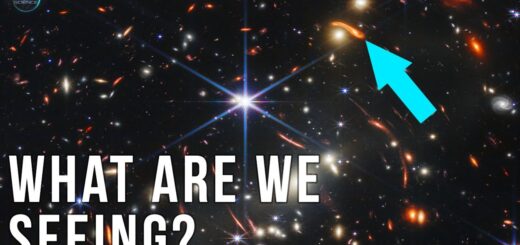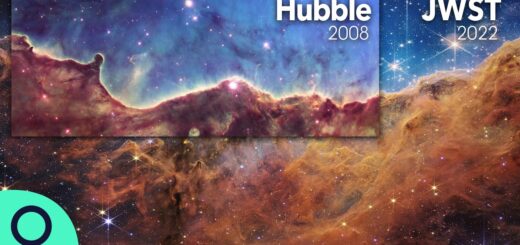Is James Webb Telescope Shattering The Big Bang Theory?
Is James Webb Telescope shattering the Big Bang Theory? There seems to be a rumor in the astronomical research environment that the latest findings of the James Webb Telescope are causing a lot of concern among cosmologists. Or at least, among orthodox cosmologists, those who would be willing to bet the house on the reliability of the so-called Standard Cosmological Model, with all that the attached Big Bang theory carries with it. How so? Well, apparently, after a mere one month of work Webb would have already detected objects, or rather galaxies so much too young, that according to the Standard Model they should not even exist. Already “adult” and well-structured galaxies dating back to a time when there should not even have been stars. And this is something that blatantly and repeatedly contradicts the Big Bang hypothesis that the universe began 13.8 billion years ago. If that were so, we could not see today, thanks to Webb, galaxies already recognizable as such, formed only 200 million years after the beginning of it all. In an era of the formation of the universe when there could not even be stars! The Big Bang has been defended for decades as an indisputable truth by the vast majority of cosmologists, which is why the new data brought by Webb are throwing the keepers of the orthodoxy into a panic. Who, however, do not want to drop the bone and are preparing to raise a thick smokescreen over what the Webb Telescope revealed, claiming the need for further confirmation. What do you say, let’s figure it out? Deciphering what happened in the early Universe is extremely complex. We know very little about how things happened immediately after the Big Bang. The most widely accepted scenario is that of so-called hierarchical formation. Starting 300-400 million after the big bang, small regions denser than the others would have begun to form condensations of dark and ordinary matter (dust and gas) that were initially relatively small, with irregular morphology and few stars. These protogalaxies would then have given rise to gradually larger galaxies through a merger process caused by mutual gravitational attraction. Thus, according to the Standard Model, currently accepted by the entire scientific establishment, the first true, flat, spiral-structured galaxies should have emerged-as did our own Milky Way-no less than 0.8 billion years after the Big Bang, about 13 billion years ago. Of course, for many years now cosmologists have been trying hard to corroborate this theory, trying to push their observations farther and farther into the past. Understanding when and how the first stars, and then the first galaxies, were formed, and what shape the latter had, is a mandatory step to somehow advance a scientific discipline like cosmology. Which by its nature lives more on hypotheses than on data and observations; and which to advance demands the use of delicate and very expensive instrumentation such as space telescopes. “Hey, guys, just a moment before we continue… BE sure to join the Insane Curiosity Channel… Click on the bell, you will help us to make products of ever-higher quality!” Until a few days ago, the record for the most distant (and therefore oldest) galaxy was in fact held by GNz-11, a primordial dwarf galaxy observed by Hubble and 13.4 billion years distant in time. Value this quite accurately, since it was possible to highlight a very precise line in the spectrum and compare its redshift with that of the same line observed in a normal terrestrial laboratory. The strange name of this object comes from being in the GOODS-North galaxy survey archive and from the number 11, which indicates the cosmological redshift value, which in cosmology is denoted by the letter “z.” The higher the value of z, the greater the distance involved. The most distant galaxies visible with the Hubble Space Telescope generally show a z of less than 10, while the most distant protogalaxies, the first ones formed after the Big bang and never observed before the advent of the Webb Telescope, are expected to show a z of more than 15. Since the universe is expanding in a relativistic space, it is very complex to uniquely define the distance of a very distant galaxy. It all depends on our point of view. Just an example: imagine that two galaxies are close to each other when the expanding universe is only 1 billion years old. Assume now that the first galaxy emits a light pulse, and the second galaxy receives the pulse after 14 billion years. By that time, the light pulse will have traveled 13 billion years, the galaxies will be separated by an effective distance of about 26 billion light years, and the hypothetical astronomers of the second galaxy will have received an image of the first galaxy when it was only 1 billion years old! As can be seen, there are thus several ways to consider distances and ages in an expanding universe, which sometimes leads to some confusion when popularizers talk about “oldest galaxy” or “youngest,” or “most distant” For small distances (below about 2 billion light-years, where z is roughly equal to 1) all the various distance scales converge and become the same, so it is much easier to define the distances of galaxies in the local universe around us. In the case of GNZ-11, the galaxy found by Hubble, the z equal to 11 means that light from this galaxy has traveled 13.4 billion years between the time the light was emitted and today. It also tells us that this same galaxy is at this moment 32 billion light-years away from us and that the image recorded by Hubble is that of a very young galaxy, formed about 300 million years after the Big Bang. At first glance, the distance of 32 billion light-years might seem absurdly large in a Universe that is only 13.8 billion years old. However, due to the expansion of the Universe, the distance of 2.7 billion light-years that existed between GN-z11 and the Milky Way at the time light was emitted increased by a factor of (z+1)=12 to measure 32.2 billion light-years during the 13.4 billion years it took light to reach us. Be that as it may, the fact that such a massive galaxy existed so soon after the first stars began to form is to be considered a challenge to ii current theoretical models of galaxy formation. Then, in April 2022, HD1 was found, observed only from Earth with suitable infrared instrumentation. This was a fluke, due to the object’s intrinsic brightness and the very long exposure time with which the image was captured. The result was a rather “strange” object since it can only be an “outburst” galaxy, i.e., one capable of forming several giant stars in a very short time (100 solar masses per year!) or a quasar, such as to indicate the presence of a black hole of at least 100 million solar masses. The redshift z was found to be 13.3, which is equivalent to saying that the object is 33.3 billion light-years away and that its light took 13.44 billion light-years to reach us, starting 330 million years after the Big Bang. If its age was just that, it would certainly not be easy to explain how it could have already created stars so bright and at such a rate or, otherwise, how it could have already possessed a black hole of such a size… So much for the past. But, now, Webb has arrived. What is the big difference between Hubble and ground-based telescopes? That it can collect much more light for the same exposure time and that it can observe very well in the infrared up to wavelengths of 5 microns (as opposed to Hubble’s 1.6). In short, what used to be flukes may be much more frequent and common occurrences for Webb. And indeed, even though he just started observing, Webb was able to detect in his first Deep field two galaxies located almost the same distance from HD1! But that was not the end of it… A few days passed…and as part of the CEERS (Cosmic Evolution Early Release Science Survey) program, the HD1 record was even shattered with the discovery of a galaxy – CEERS-93316 – showing a z of 16.7! Such a high redshift tells us that the galaxy light collected by Webb may have started just 233 million years after the Big Bang! We use the conditional because. it is important to emphasize that these Webb measurements are not spectroscopic in the strict sense of the word, as such objects are too faint to record their spectra with a resolution that would allow us to highlight particular lines in emission and absorption; which would allow us to clearly and unambiguously establish the redshift. All the results announced so far are therefore subject to possible alternative interpretations, even if unlikely, and we have no absolute certainty about the magnitude of the redshift. However, the authors point out the non-stellar appearance of these objects, further supporting their galactic nature, Another objection put forward by the staunch defenders of the Big bang Theory is that these galaxies could be “imposter galaxies,” meaning that they could be such dust-rich objects that their very high redshift could come from the resulting reddening rather than from their distance. A team led by Jorge Zavala (National Astronomical Observatory of Japan), even claims that this galaxy may actually have a much smaller redshift of 5, corresponding to a galaxy only 12.6 billion years away in time… In many of the articles that have been published so far commenting on these latest sensational findings, the authors state that their results, if confirmed, could instead challenge the standard model of cosmology, according to which the very first galaxies should have formed no earlier than 300 million years after the Big Bang; and what is more, in the form of very few extended, faint objects with few stars. Instead, some of the remote galaxies found by Webb appear to be already highly evolved in terms of structure, with some already containing about 1 percent of the mass of our galaxy; and in numbers ten times larger than previously assumed. Finally, studies of galactic chemistry also show a very complicated picture. An early Deep field analysis carried out by Webb examined the light emitted by galaxies with a redshift of 5 or higher, finding a surprising richness of heavy elements, such as oxygen. This finding is again at odds with what the standard model predicts, according to which the chemical enrichment process (in which stars fuse hydrogen and helium to form heavier elements) should take much longer. More broadly, according to a large staff of researchers, the first images produced by the Webb telescope would show dozens, hundreds, perhaps even a thousand times more bright galaxies in the early universe than predicted up to a month ago. And there is no way that so many large galaxies could have been generated in such a short time… In short, it certainly looks like James Webb Telescope is poised to rewrite the astrophysics textbooks on which thousands of students have trained for years. Are you also ready for the great revolution?













